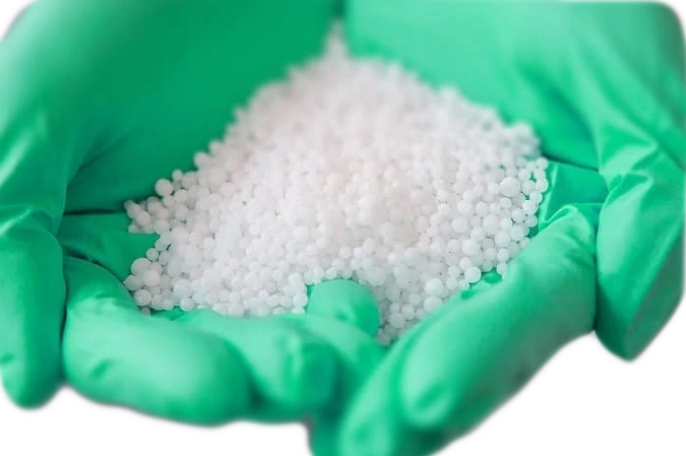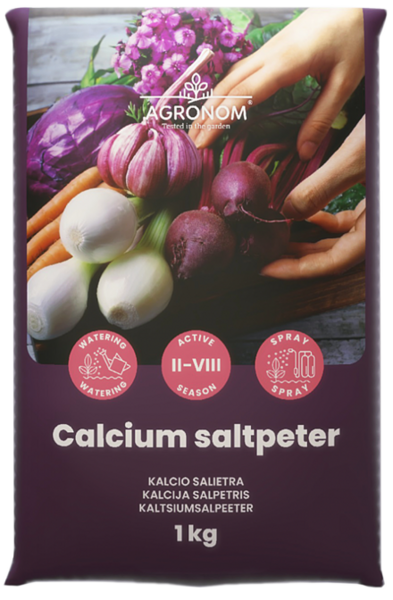Universal nitrogen and calcium fertilizer.
Before use, dissolve fertilizer in water. Not suitable for Ericaceae plants.
Fertilizer rate: for watering – 10–30 g/10 l water, for spraying – 50 g/10 l water.
EC FERTILIZER. Fertilizer type: A.1.1a.
Composition: nitrogen (N) – 15,5% (ammoniacal nitrogen (N-NH4) – 1,1%, nitrate nitrogen (N-NO3) – 14,4%), calcium oxide (CaO) – 26,3%.
Active substances contained in fertilizer are fully water-soluble.
In case of physical changes, the nutritional properties of fertilizers do not change. When the fertilizer is kept dry and protected from direct sunlight, the term of use is unlimited.
* Thanks to calcium, which is part of this fertilizer, nitrogen is actively absorbed by the roots of plants - this is especially true for highly acidic soils.
It is difficult for plants to absorb nitrogen from acidic soil, and ammonium nitrate and carbamide are known to increase pH.
Thanks to the use of calcium nitrate fertilizer in the garden, it is possible to normalize acidity, which can be seen 2–3 weeks after application. Beneficial bacteria are activated in the soil, thereby improving its structure and composition.
It neutralizes the harmful effects of metals and salts, preventing them from entering plant tissues.
Feeding plants with calcium nitrate accelerates plant growth, and due to the fact that the product neutralizes excess metals, such as iron and manganese, which are found in large quantities in acidic soils, plants begin not only to grow rapidly, but also actively develop throughout the growing season.
In the event of a lack of calcium, the roots begin to “die off” in plants, as they do not receive the necessary nutrients. The imbalance causes the roots to absorb water poorly and begin to rot, which can eventually lead to the death of the plant.

Instructions for use of calcium nitrate.
Calcium nitrate is an ideal option for pre-sowing application, since it is nitrogen that plants need at the initial stage of their development, and, as noted above, it is absorbed only with the help of calcium. Fertilizer is also recommended to be applied at the beginning of the vegetative development of crops as a foliar top dressing.
The method of application and the consumption rate depend primarily on the type of crop, type of soil.
To benefit from calcium nitrate, application rates must be calculated for each cultivated crop. The dosage depends not only on the type, but also on the age of the plant.
Regardless of the amount of fertilizer, the soil must be well moistened before processing - this will protect the root system of plants from burns.
Berry and vegetable crops: 1-1.5 liters of the finished solution are used per 1 m².
Feed for cucumbers.
Given that the underground part of cucumbers is characterized by slow development, it is necessary to carefully apply fertilizer. As soon as 3 adult leaves appear, the seedlings can be sprayed with calcium nitrate.
Top dressing under the root is carried out every 8-10 days until the stage of formation of the ovaries. The solution is prepared at the rate of 2 g of fertilizer per 1 liter of water. This top dressing will protect the roots of cucumbers from decay.
Top dressing for tomatoes.
Tomatoes are sprayed with a solution prepared in the same proportion as for cucumbers. The first time the tomatoes are processed after 1 week from the moment the seedlings are planted in the ground, and since the fertilizer has a long-term effect, even after the cessation of fertilizing, it continues to protect the crop from various pathogenic influences: for example, black rot, top rot, as well as from pests such as slugs , thrips and mites.
Experienced gardeners know what to do if the tomatoes are sick with blossom end rot - they prepare a solution of calcium nitrate, which helps stop the spread of the disease.
It is even better not to wait for signs of diseases, but to use this fertilizer for prevention.
Fertilizer for cabbage.
This culture especially needs calcium nitrate, which can be applied at the seedling stage. The solution (proportion, as for cucumbers and tomatoes) is applied directly under the root.
Since cabbage does not like acidic soils, and therefore especially needs calcium, it is best to apply fertilizer not while digging the soil, but directly into the hole when planting seedlings.
To do this, 1 teaspoon of saltpeter is added to each well, sprinkled with earth a little, and only after that cabbage seedlings are planted. It will be immediately noticeable how the cabbage will begin to grow rapidly, its leaves will begin to actively develop, twist into heads. In addition, the plant will be protected from diseases.
Fertilizer for flower crops.
Promotes annual and perennial flowers to actively develop, increase green mass, bloom profusely and resist diseases.
For 1 m², 1-1.5 liters of solution will be required.
If you use calcium nitrate for flowers, you can protect plants from decay, improve the formation of greenery. Root applications are carried out from the beginning of the season every 10 days. If the buds become smaller, then root treatment is alternated with spraying on the leaf.
For example, to process phloxes, 2 g of saltpeter will be required to prepare a solution with a volume of 1 liter. Top dressing is carried out twice with an interval of 10 days. After the flowers have been fertilized 2 times, it is advisable to carry out foliar spraying on the leaves.
Petunia seedlings, which are very fragile, are recommended to be fed under the root with a solution in the ratio of 1 teaspoon of calcium nitrate per 1 liter of water. It is advisable to carry out the same top dressing during the period when the seedlings are planted in the ground.
Berry crops in the initial phase of development.
Feed 1-2 times. Consumption rate for the preparation of the solution: 25 g of saltpeter per 8-16 liters of water
Garden strawberries are fed before flowering. Raspberries and berry bushes are fed until the buds open. In 10 liters of liquid dissolve 30 g of the drug, which is abundantly watered with plantings.
Vegetable crops.
It is recommended to fertilize twice with an interval of 15 days. Consumption rate: 25 g of saltpeter per 10-15 liters of water.
Shrubs.
1 bush absorbs 1.5-2 liters of nitrate solution.
Fruit trees.
Fertilize when buds start to open. Consumption rate: 25 g of saltpeter per 10 liters of water.
Foliar top dressing (spraying on the leaf), the working solution is prepared at the rate of 25 g of saltpeter per 1 liter of water.
Compatibility of calcium nitrate with other drugs.
In parallel with calcium nitrate, urea (urea) and crushed wood ash can be used.
All organic fertilizers, sawdust and straw are contraindicated for joint use.
It is forbidden to mix calcium nitrate with:
lime
chalk
plant growth stimulants
agrochemicals based on phosphorus and sulfur.
Benefits of calcined nitrate:
* Helps strengthen plant rhizomes, resist various diseases caused by all kinds of bacteria.
* After feeding, plants painlessly tolerate various weather changes (drought, frost)
* Stimulates the formation of cell membranes and walls
* Takes a direct part in the metabolism, enhances the work of enzymes
* Accelerates the process of photosynthesis, takes part in the transport of carbohydrates and has a positive effect on the absorption of nitrogen
* Guaranteed 15% yield increase
* Increases the shelf life of the crop, improves the quality of the fruit.
The disadvantages of calcium nitrate are associated with incorrect timing of application and violation of the recommended dosage.
Attention! It is necessary to make calcium nitrate in the spring along with digging the site. If it is applied in the fall, the fertilizer will not be effective, since the nitrogen in the soil is washed out and only calcium remains.












